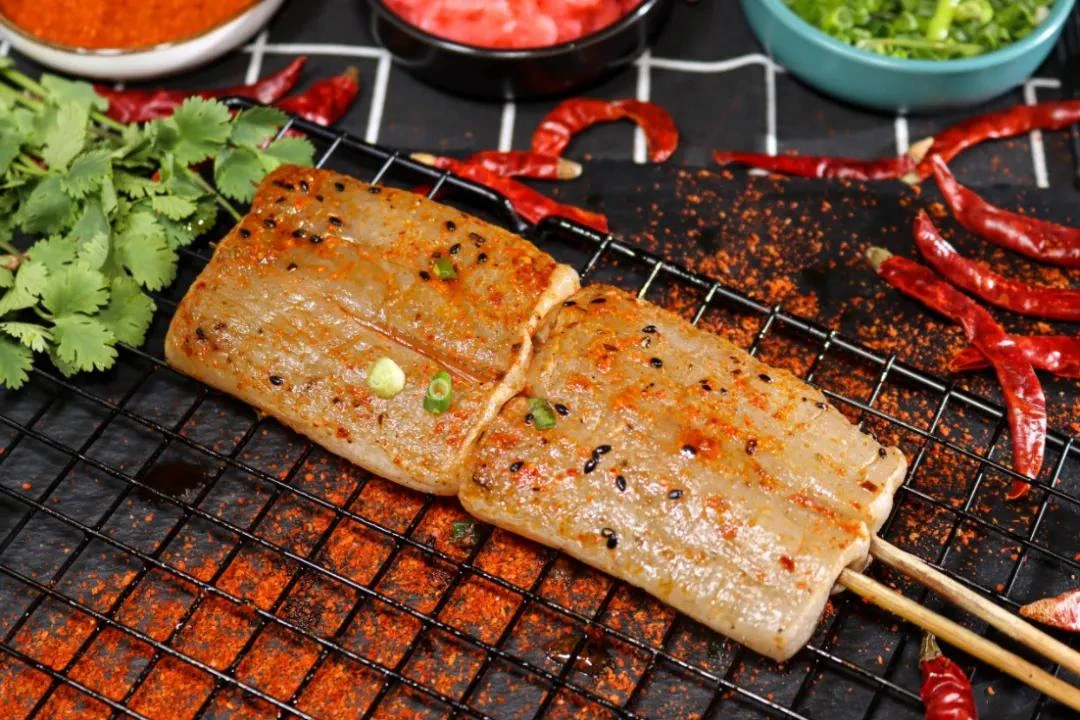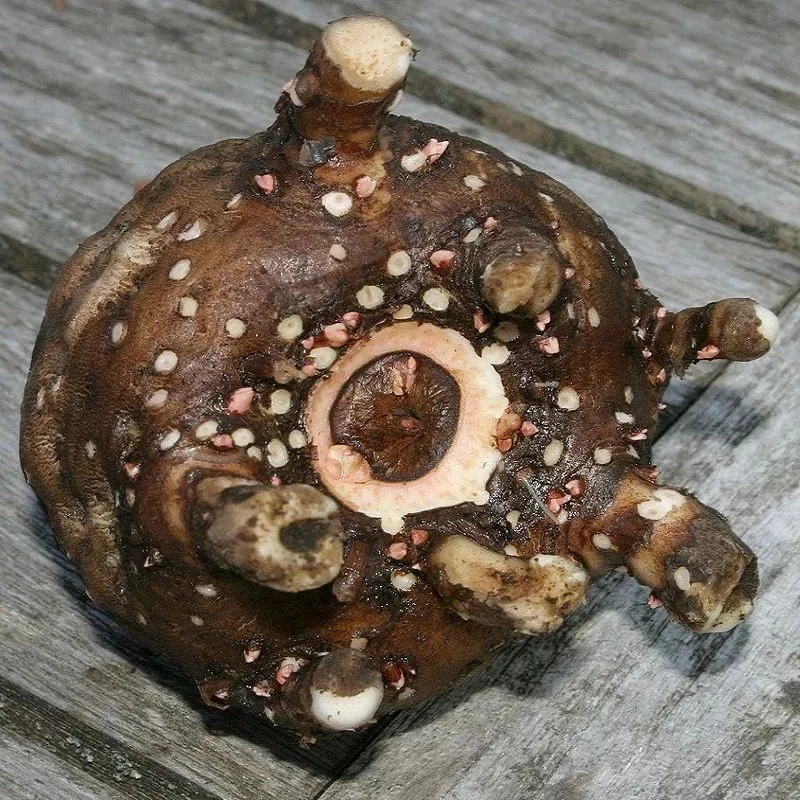For those not from konjac-producing regions, the most common encounters with konjac (魔芋) might be in convenience stores. The konjac knots and konjac tofu in oden may not have a distinct flavor but soak up the broth's essence, offering a delightful texture and a sense of healthiness. On snack shelves, the konjac-based "Moyu Shuang," which mimics tripe, and the konjac jelly, known as "konnyaku," are popular items.
In the southwest regions of China, where konjac is abundantly produced, it has become a culinary star, transforming in various dishes to win over everyone's palate. How delicious can konjac be? Let's dive in and find out!
Konjac's Struggle Against Its Culinary Fate
Many people enjoy eating konjac, yet few have seen the plant in its natural form. Konjac belongs to the Araceae family, with a tuberous underground stem that is flattened and spherical, topped with a dimple. It grows a tall spadix, which emits an unpleasant odor when it blooms, attracting insects for pollination. Konjac's growth cycle is long, spanning 3-4 years, during which its tuber becomes rich in calcium oxalate, a toxic substance. Consuming raw konjac can lead to severe vomiting and diarrhea or even kidney failure.
Direct contact with unprocessed konjac can cause intense itching and pain, especially if it touches an open wound. These characteristics show how konjac has evolved to deter consumption, yet it has still ended up on human plates.
Over a thousand years ago, people in Sichuan found a way to safely consume konjac. They peeled and shredded the tuber, washed away the calcium oxalate with water, and cooked it with alkaline substances like plant ash to remove toxins. Another method involved drying and grinding konjac into powder, then cooking it with alkaline water to form a solid mass. These processing techniques have been passed down, ensuring that the konjac sold today is safe to eat.
The processing of konjac is somewhat similar to making tofu, which is why some regions call the alkaline-treated konjac product "konjac tofu." As noted in Qing dynasty records, "One tuber can make a whole pot," due to konjac's high content of water-soluble dietary fiber, glucomannan. This substance absorbs water and expands, forming a gel-like texture that is slightly translucent, finer than tofu, and more flexible than jelly.
Common konjac blocks and noodles are often grayish with black specks because they are made from "crude powder," retaining some of the skin's fragments. The konjac used in hot pots and oden is made from "refined powder" after peeling, resulting in a white color.
Delightful Ways to Enjoy Konjac
Konjac is extremely low in calories but highly satiating, making it an excellent diet food. It often features in light meals, paired with other vegetables in salads or cold dishes, or even as a substitute for staple foods.
However, konjac can also become an irresistible temptation, particularly in Sichuan, Chongqing, and Guizhou. Any konjac dish there is sure to make you eat a few extra bowls of rice.
Although konjac itself is flavorless, it absorbs the flavors of other ingredients and becomes more flavorful the longer it cooks. One of the most popular Sichuanese dishes is konjac braised with duck. The rich duck meat is first browned to remove excess moisture, then simmered with konjac until tender. The dish, seasoned with pickled peppers, ginger, and doubanjiang, is irresistibly fragrant and spicy, with the konjac soaking up all the delicious flavors and becoming the first thing diners reach for.
Substituting the duck with chicken or chicken offal still makes for a beloved konjac dish. In Changsha, konjac is a staple in the spicy "kouwei shrimp," absorbing the rich crayfish broth and offering a wonderful contrast in texture and taste.
In Guangyuan, Sichuan, konjac is humorously called "gray vegetable," often mistaken for a similarly named wild vegetable by outsiders. One popular local dish involves slicing konjac into strips and stir-frying it with homemade pickled vegetables and chili, creating a tangy, appetizing flavor that stimulates the appetite. A similar dish can be found in southern Shaanxi, near Sichuan.
Thinly sliced konjac frequently appears in Sichuan and Chongqing hot pots and skewers, rivaling the popularity of sweet potato noodles. When grilled, konjac slices puff up and become chewy, making them a favorite street food item, often brushed with chili and skewered for a quick, satisfying snack.
In Guizhou, konjac is a star ingredient in the local specialty, "baked pot (烙锅)," a dish where nearly anything can be baked. Konjac develops a crispy, golden crust while retaining its springy texture. After being dunked in dipping sauce or dry spices, it becomes an aromatic and flavorful delight.
The konjac family also includes a unique variety known as "snow konjac," originating from Mount Emei. Traditionally, freshly made konjac tofu is frozen outdoors in winter, creating a process similar to making frozen tofu. The ice crystals fill the internal pores, which are then dried under the sun, making snow konjac easy to preserve. When rehydrated, it becomes sponge-like, pairing well with various ingredients. When braised with meat, it absorbs the broth better than regular konjac, offering a chewier texture and richer flavor.
Conclusion
Konjac, despite its initial attempts to fend off consumption with its odor and toxicity, has become a beloved ingredient in many culinary traditions. Its unique texture and ability to absorb flavors make it a versatile component in countless dishes, from hot pots and braises to salads and snacks. Whether you encounter it in a convenience store snack or a hearty Sichuanese stew, konjac's journey from an unlikely food source to a culinary staple is truly fascinating.
So, the next time you encounter this unassuming tuber, remember the journey it has undergone to become a cherished part of many traditional dishes. Konjac is more than just a food; it's a symbol of resilience and the endless possibilities of culinary creativity.




